Abstract
LOCUST hoppers of the gregarious phase are attracted towards one another and so form groups. Such social aggregation depends on learned reactions and is not shown by hatchlings or by individuals which have lived in isolation (solitary phase). In contrast, the vigorous marching shown by bands of gregarious locusts is not learned and is exhibited in a lesser degree by solitary hoppers1. The amount of marching is related to the general level of activity of the animal and is greater in larger than in smaller groups of hoppers. Not only does the vigour of marching depend on the degree of crowding of the hoppers, but also on the history of their parents. The offspring of crowded parents march more vigorously than those from isolated parents2.
This is a preview of subscription content, access via your institution
Access options
Subscribe to this journal
Receive 51 print issues and online access
$199.00 per year
only $3.90 per issue
Buy this article
- Purchase on Springer Link
- Instant access to full article PDF
Prices may be subject to local taxes which are calculated during checkout
Similar content being viewed by others
References
Ellis, P. E., Anti-Locust Bull., 7 (1951).
Ellis, P. E., Insectes sociaux, 6, 21 (1959).
Ellis, P. E., and Carlisle, D. B., Nature, 190, 368 (1961).
Ellis, P. E., and Pearce, A., Animal Behaviour, 10, 305 (1962).
Haskell, P. T., and Moorhouse, J. E., Nature, 197, 56 (1963).
Author information
Authors and Affiliations
Rights and permissions
About this article
Cite this article
CARLISLE, D., ELLIS, P. Prothoracic Gland and Gregarious Behaviour in Locusts. Nature 200, 603–604 (1963). https://doi.org/10.1038/200603b0
Issue Date:
DOI: https://doi.org/10.1038/200603b0
This article is cited by
-
Hormones in insect behaviour
Proceedings: Animal Sciences (1985)
Comments
By submitting a comment you agree to abide by our Terms and Community Guidelines. If you find something abusive or that does not comply with our terms or guidelines please flag it as inappropriate.



